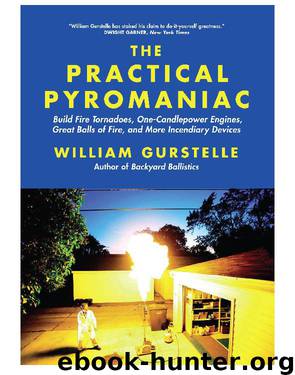The Practical Pyromaniac by William Gurstelle

Author:William Gurstelle
Language: eng
Format: epub
Publisher: Chicago Review Press
Published: 0101-01-01T00:00:00+00:00
8
Exploding Bubbles
Antoine Lavoisier was an extraordinary man who led an extraordinary life and died an extraordinary death. He, in large part, laid the foundations of modern chemistry, allowing the scientists who followed him to determine the true nature of fire.
In 1794, Lavoisier was living comfortably in Paris, a man of enough leisure to study chemistry as a hobby in a well-outfitted laboratory that he set up in his home. He had trained as an attorney, but his money came from his position in the French government as Fermier-General, a special type of tax collector in the employ of the king of France. That was a very good job to have, at least before the French Revolution. In exchange for a fee paid to the royal government, Lavoisier, like his father before him, was given a monopoly on the sale of tobacco in a particular region of France. He bought low and sold high, and his fortune amounted to the modern equivalent of nearly $3 million.
With such wealth, Lavoisier could afford to quit his job and devote himself to the chemistry experiments that had become his passion. Lavoisier became famous throughout Europe for a great number of contributions to chemistry, including describing in detail the chemical reactions of what we now call combustion.
Lavoisier also developed the nomenclature modern chemists use to describe chemicals. The importance of this contribution cannot be overstated. Prior to the textbooks he wrote, there was no consistent, clear way to describe chemical substances or compounds. For example, if a man named Glauber or Epsom discovered a salt of some chemical interest, it was called “Glauber’s Salt” or “Epsom’s Salt.” Substances were called by names as such sal-ammoniac, vitriol, and spirit of wine (now called ammonium chloride, sulfuric acid, and ethanol, respectively), none of which made sense in a larger context. The nomenclature system Lavoisier devised made scientific work and study much simpler and far more straightforward.
At the age of 50, Antoine Lavoisier was at the pinnacle of his chemistry career and seemed poised to go on to even greater achievements. Alas, the period of the French scientist’s creativity and experimentation was about to end as the infamous Reign of Terror of the French Revolution unleashed political anger. Lavoisier wrote to his close friend and fellow scientist Benjamin Franklin in America, saying that he wished Franklin were in France to serve as an adviser and exemplar and perhaps to cool down the increasingly toxic political climate.
I greatly regret your absence from France at this time. You would have been our guide and you would have worked out for us the limits beyond which we ought not to go.
Indeed, limits were not a key part of the French Revolution. After each mass execution of the Revolution’s “enemies of the Republic” (and there were many of them), throngs of fanatics, their fervor raised by the sight of the guillotine’s work, paraded the streets. Often drunk and purposely dressed in the shabbiest of clothing, the mob, called the “sans culottes,” (meaning
Download
This site does not store any files on its server. We only index and link to content provided by other sites. Please contact the content providers to delete copyright contents if any and email us, we'll remove relevant links or contents immediately.
| Electron Microscopes & Microscopy | Experiments & Projects |
| Measurement | Microscopes & Microsocopy |
| Scientific Instruments | Telescopes |
| Time | Methodology & Statistics |
Hands-On Genetic Algorithms with Python by Eyal Wirsansky (2020) by Unknown(4086)
Thing Explainer by Randall Munroe(3911)
The Elements by Theodore Gray(3028)
The Meaning of it All by Richard Feynman(2320)
Make by Mike Westerfield(2304)
Every Tool's a Hammer by Adam Savage(1914)
Science Experiments You Can Eat by Vicki Cobb(1855)
The Perfectionists by Sara Shepard(1805)
Martin Gardner's Science Magic by Martin Gardner(1708)
Raspberry Pi Electronics Projects for the Evil Genius (Tab) by Norris Donald & Norris Donald(1688)
Elephants on Acid by Boese Alex(1580)
Elephants on Acid: And Other Bizarre Experiments by Alex Boese(1576)
The Perfectionists by Simon Winchester(1573)
Handbook of Modern Sensors by Jacob Fraden(1560)
Synchrotron Light Sources and Free-Electron Lasers by Eberhard J. Jaeschke Shaukat Khan Jochen R. Schneider & Jerome B. Hastings(1540)
Tesla by Carlson W. Bernard(1503)
The Science of Food by Marty Jopson(1463)
125 Physics Projects for the Evil Genius by Silver Jerry(1431)
The Meaning Of It All by Richard P. Feynman(1431)
